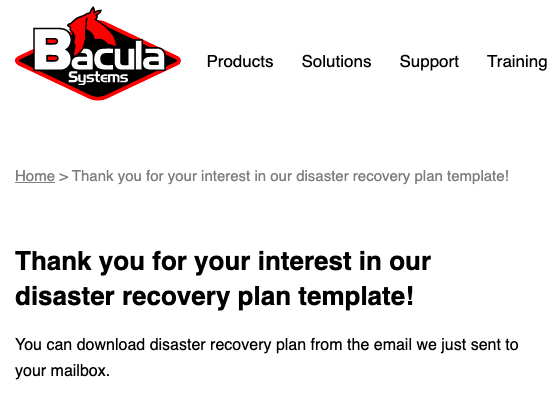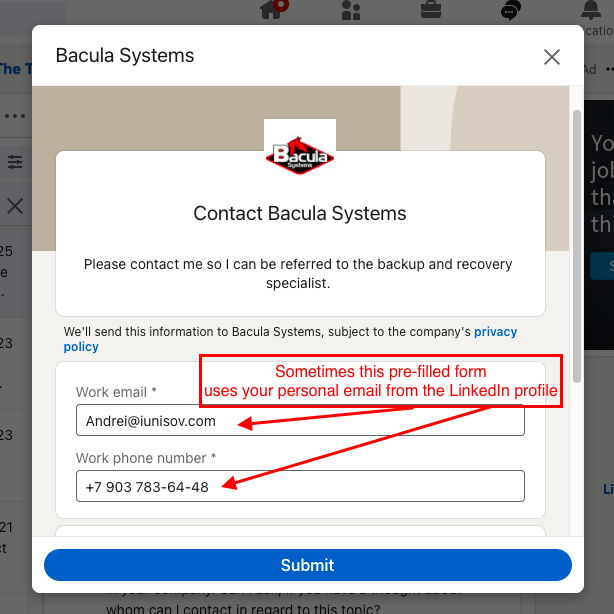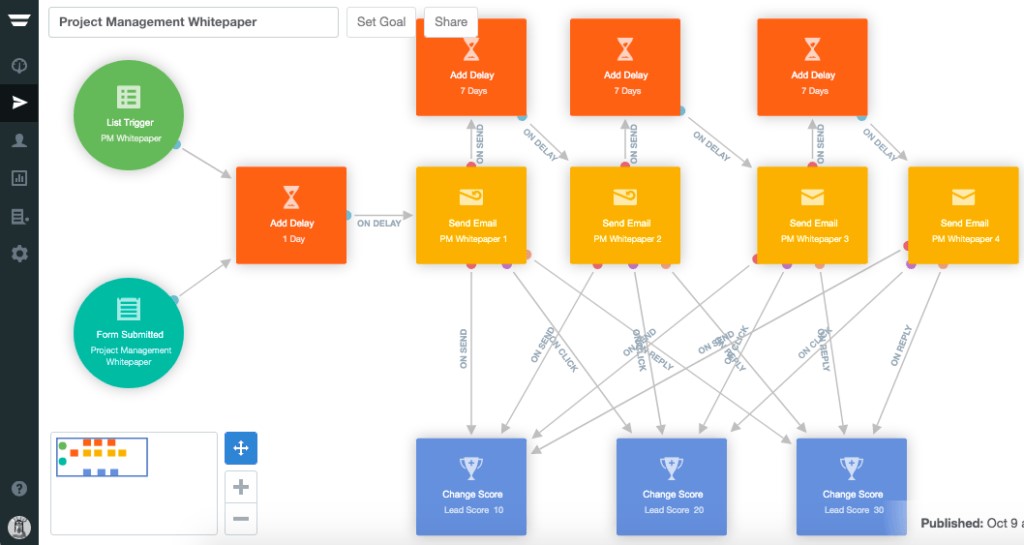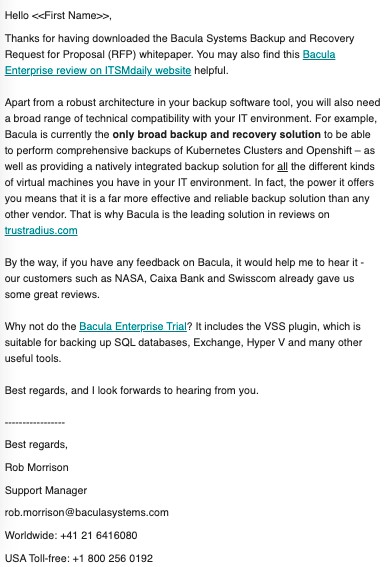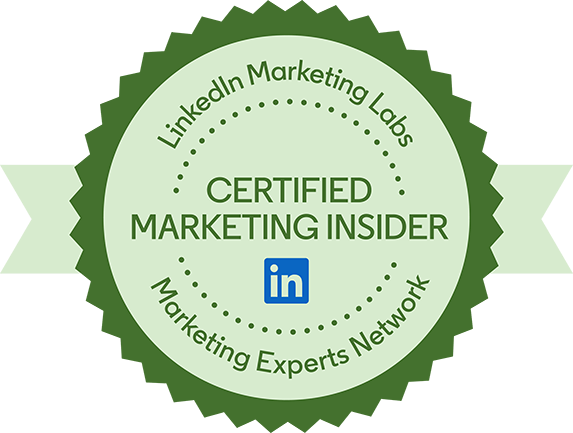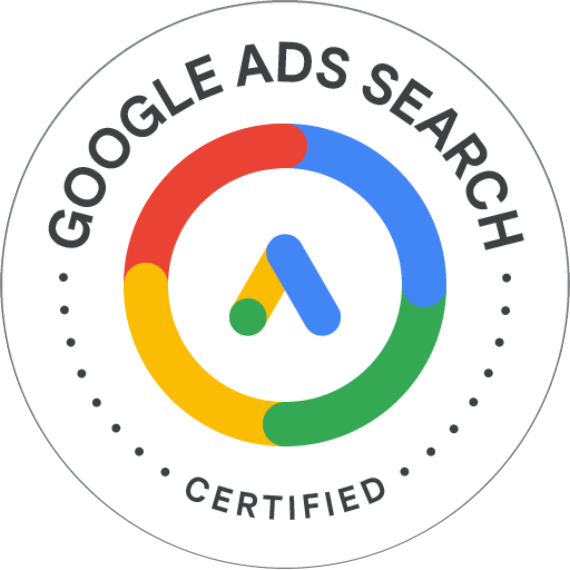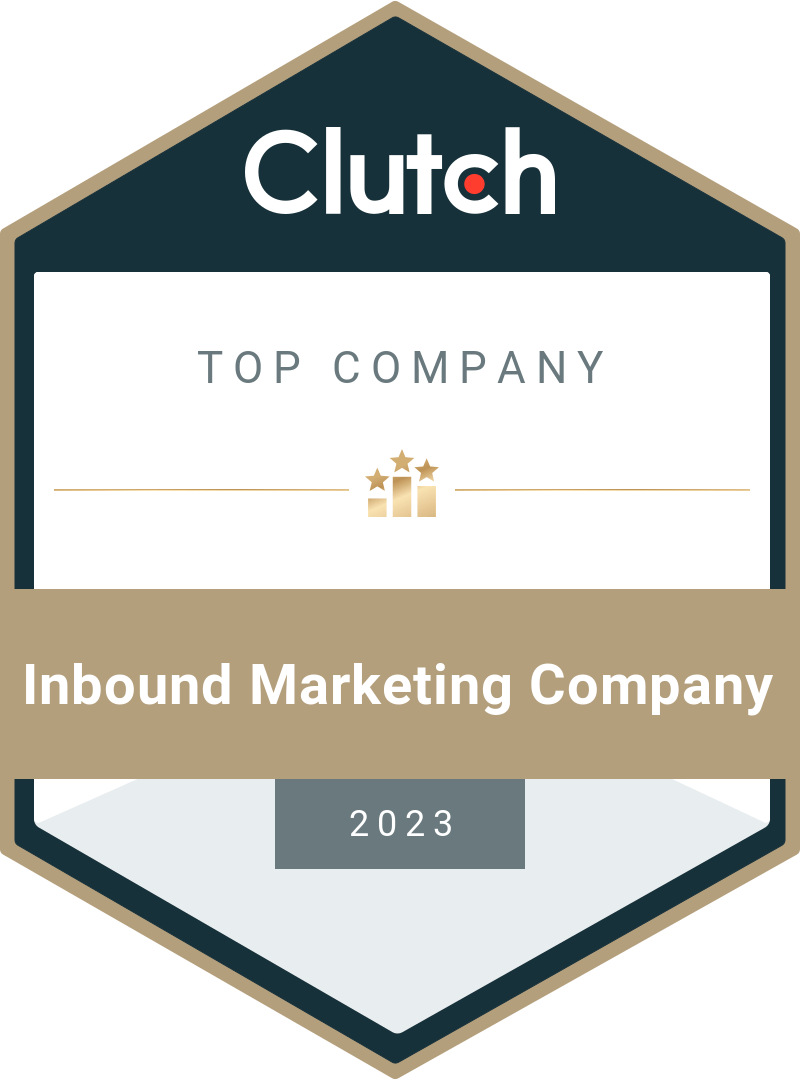How To Improve Lead Quality? A Complete Guide to an Increased Lead Quality.
Date : April 26, 2021 By
Contents
Key Takeaways
- Lead quality improvements consist of improved targeting, website and content changes.
- Read the article to get insights on strategies that improve lead quality for marketing and sales teams.
It’s a common situation in B2B digital marketing when there are tons of incoming leads, but the number of opportunities created from them is relatively low. This is where the topic of lead quality and qualification comes in.
According to the TOPO Demand Generation Benchmark Report 2021, 62% of respondents have cited focusing on lead quality instead of lead quantity as one of their top priorities in demand generation. Additionally, low-quality leads not only have a low chance of conversion but also tend to drain the resources of the company, providing a net negative effect on the overall marketing effort.
There are many different metrics that can be used to assess lead quality – and it’s also important not to get carried away with analyzing everything at once. Focusing on the correct metrics is the key to success.
In this article, we are going to review actionable strategies for lead quality improvement, for example, messaging enhancements, using data for improved lead generation success rates, and other examples. However, it is important at first to figure out the correct definition of a lead, as well as several other basic factors, before delving into more details on the subject.
The definition of a high-quality lead, MQL and SQL
A prospective customer willing to buy your product or service in the sales field is called a lead. It is the most important growth resource for any B2B business since only leads can be turned into future new sales, and obviously no business can grow without sales. This is where another definition comes in – a high-quality lead, which has a high chance of converting into a purchase. A high-quality lead has a strong interest in your product or service with an intention to try or buy it. This creates a simple logic – the higher lead quality is, the bigger is a chance of this lead becoming a paid customer for your business.
There are also two acronyms we mentioned above that may not be familiar to some people – SQL and MQL. These are basically two main types of leads that marketing efforts can spawn.
Marketing qualified leads (MQLs)
MQLs are the leads that you have attracted with your marketing efforts and these leads can go through your primitive qualification criterias like valid name, valid contact information, decent company size, target location, and other criterias that you may have. These leads have not yet interacted with your sales team in some way or another, aside from showing interest in your product by downloading whitepapers, requesting more information or doing any other target action that led to leaving the information in exchange for a gated asset.
Sales qualified leads (SQLs)
SQLs are the leads that have already gone into the next step of your sales funnel and interacted with your sales team. Usually the inside sales team should confirm the real interest in purchasing your product or service and later transfer these leads to deal closers. Here is the small concept describing a typical SQL:
- What? – is there a project in the lead’s organization?
- When? – is there a deadline for a purchase?
- Who? – who is going to make a purchase decision, who is the buying center?
If you have the answers to these questions, then it means your lead is the SQL. Because lead quality is critical to the overall sales organization of your company, the topic of lead quality identification is extremely important – and it has its own nuances and factors. There are multiple factors that can be used to determine the quality of a lead, and this particular topic requires its own segment in the article.
11 key factors for lead quality identification
- Need – Does this lead actually need our product/service?
- Revenue – How much revenue can this lead bring to our company?
- Budget – Does this lead have a budget to afford our product/service?
- Interest – Is there any interest from this lead towards our product/service?
- Authority – Can this lead make a decision about purchasing our product/service?
- Timeframe – How quickly can the decision be made?
- Interactions with your brand – How often does the lead interact with your brand’s social media page? Or how much is the likelihood of opening your brand’s email?
- Referrals — Does the lead come through any referrals from your existing client?
- Brand affinity — Does the lead align with the value and mission of your brand or not?
- Demographics — Does age, gender, or location of the leads align with the demographics of your target audience?
- Lead source — Did the lead come from the source that has proven to attract users with high purchase intent?
These eleven factors provide a comprehensive framework for assessing lead quality. By evaluating leads across these dimensions, businesses can prioritize their sales efforts. This approach improves sales efficiency and leads to higher conversion rates. Regularly refining these criteria based on actual outcomes will help organizations continually improve their lead qualification process.
The benefits of a higher lead quality
There are multiple benefits of an improved lead quality for the company:
- For marketing – a higher-quality lead can attract additional leads by the word of mouth which reduces the overall marketing budget;
- For sales – higher-quality leads reduce the inside sales workforce and allow saving on resources and freeing resources to close deals;
- For finance – if the leads have higher quality under specific qualification criteria, they tend to be more solvent than the lower-quality ones.
With the increase in lead quality the overall cost of sales goes down and marketing budget is spent more efficiently with a higher ROI. In addition to being more payable, high-quality leads have higher LTV and retention which positively affects your company’s profits.
The 16 actionable tips to improve lead quality
Lead generation as a whole is an unstable process, and it might be really hard to start bringing in quality leads from the get-go. However, there are also many different tips and tricks that can be used to circumvent or avoid those lead generation problems altogether. The list of tips includes, but is not exclusive to:
Form a feedback loop between departments
When it comes to B2B companies and their extremely long sales cycles, it’s important to maintain regular communication between marketing and sales teams. A lead quality assessment must be performed as early as possible so that all of the potential benefits and lessons from this lead can be used in the future operations.
For that exact reason, it is recommended for sales and marketing teams to report to each other in a closed loop on a regular basis. That way, sales activity reports can be provided to marketing, and more information about the client, in general, is sent to the sales department.
There’s a particular example I’ve seen while working with Bacula Systems and their departments. Bacula’s sales department segregates its leads into five different groups:
- #1 – This lead is not a lead at all;
- #2 – The information behind this lead seems to be real, but the project behind the request is absent;
- #3 – This lead can be converted into a sales opportunity, with some time and effort;
- #4 – This lead can be converted into a sales opportunity within a relatively small time frame (about two weeks or less);
- #5 – This lead has all of the signs of a high-quality lead, being a concrete project, with one of the lead types that we’re looking for and a high chance of closing a deal.
After the classification process is complete, this information is sent to a marketing team and then used to correct various marketing campaigns in favor of a company’s own needs.
Set up a company-wide definition of a qualified lead
The number of companies that don’t have a company-wide definition of a qualified lead is surprisingly high since the misunderstanding between sales and marketing departments could easily have a lot of unpleasant aftereffects. On the other hand, the existence of a unified definition of a “sales-qualified lead” that both marketing and sales teams agree with is crucial for better cooperation and easier work with clients, among other benefits.
For example, in Bacula Systems the definition of the SQL is:
- There is a specific backup system project in the nearest month;
- We’re talking to the person in the “buying center” of the company;
- We know all the other people in the “buying center”;
- The lead is in our target customer segment from the size perspective;
- The lead is in our target customer segment from the industry vertical perspective;
- The lead is geographically in one of our focus regions.
Improve the quality of lead generation contact data
I’ve seen some examples where SEO, Google Ads or the other lead generation sources generate more than a hundred of new leads per sales person in the region but this person only works with 2-3 opportunities a month. One of the multiple reasons of this is connected with the quality of the leads’ contact information.
The most common issues with the contact information include:
- fake emails;
- emails from non-business domains.
Usually when the sales person opens a new lead in CRM, it’s vital to have the correct email and the business domain in it – these 2 attributes demonstrate the high quality of the contact and increase the processing priority.
It’s relatively easy to prevent the fake emails. Once your lead generation form is submitted, don’t automatically redirect the user to the material (whitepaper or case study) that he/she had requested. Just send the file to the mailbox and notify about this on the “Thank you” page:
Practically each day I see leads which left fake emails, and then after several minutes submitted the real data – after they understood that without it they won’t get the actual asset.
Not all the leads without business emails are junk – there can be various reasons why the person has left the personal email. Sometimes there is no access to the business email outside of the office, and sometimes the built-in LinkedIn forms already have the personal email automatically pre-filled because of the initial account settings.
I would suggest using RocketReach (or similar tools) when you have a lead with the non-business email. It allows to input the first and last name or LinkedIn profile URL, and then you’ll get all the possible variations of the lead’s business email. RocketReach has its own database and also the email prediction mechanism.
To overcome the problem of non-business emails you could also prevent your website forms to accept the leads with the free email domains. Here is how it looks like:
Even during the typing phase the form recognizes the email domain and informs on the issue while making the submission button inactive.
Invest in lead nurturing
Lead nurturing is a process of constantly building relationships with prospects, no matter how soon they’ll buy your product or service. Three main goals of lead nurturing are maintaining a constant connection with a prospect (to the point of a prospect being ready to perform a purchase), increasing brand awareness, and building trust.
The majority of your website’s qualified visitors are there to investigate and gather information, and not to buy immediately. However, active lead nurturing manages to turn a lot of these visitors into actual clients, after some time. Lead nurturing is usually done with the usage of email, SMS or PUSH-notifications channels.
Here’s my example of a lead nurturing campaign for a Project Management whitepaper that I did for VirtoSoftware (presented below).
List triggers and form submission are two of our starting points in this context. Both of those are followed by the first “step” in this lead nurturing campaign, which is a 1-day delay. After that, we’re entering a sequence of emails sent on a regular basis – with each email covering a different aspect of the previously downloaded project management whitepaper.
This is how the biggest part of lead nurturing is achieved – keeping up contact. By sending emails on a semi-regular basis, we can establish a connection with our leads without annoying them.
Additionally, this whole process allows us to evaluate each lead using a scoring system (three blue squares). In this situation, we’re judging prospects’ reactions to each of our emails. You can see here that sending each successful email gets this specific prospect 10 points, while the prospect clicking on the email in question counts as 20 points, and the prospect replying to one of these emails adds 30 points to the score.
One of the important aspects of lead nurturing is to make sure that your nurturing emails look personalized. The modern way of doing colorful emails is not going to work because people feel it’s an automated communication. Instead, we’re using the blank templates that look like real personal messages and generate higher reply rates. Here is another example:
Counting “points” or “score” for each of your leads is called lead scoring, and it is the next important point on this list.
Implement lead scoring
Ranking all of your leads based on a specific methodology that rates the interest level of a lead, as well as sales readiness level, is what lead scoring is all about. There might be different interpretations of high and low scores for leads in different companies, but at the same time all of them can be simplified to a combination of two factors: “interest” and “fit”.
If the fit is high, but the interest is low – a lead’s interest should be stimulated in some way (by nurturing, for example). If both the fit and the interest are high, the follow-up needs to come as quickly as possible after this realization.
If the fit is low, but the interest is high, then it’s possible to keep the connection with the lead by taking orders. Lastly, if both the fit and the interest are low, the only reasonable idea is to avoid this lead and do not spend sales resources.
If we’re talking about specific scores for each lead (i.e. 1, or 10, or 100 points, etc.), it’s possible to set up specific rules that would give leads more scores depending on some of the actions. Here’s one of the most basic examples from my own experience.
As you can see, “deep” website visits are adding 7 points, and “long” visits add 5 points. Deep website visits are usually the ones that have five or more pages of the website visited in one session (the number of pages can be customized).
At the same time, long website visits are the ones that count minutes of each visit per visitor – three minutes, in my example (the exact amount of time can also be customized).
Alternatively, it’s also possible to add many different conditions that would “add points”, from the prospect’s title to the geographical location of the visitor. I’ve explained this subject more in-depth in my other blog post about automated lead qualification.
Use a marketing automation platform & nurture leads
While both lead nurturing and lead scoring can be done manually, it is only effective if you’re working with a somewhat limited number of leads. But massive enterprises with hundreds of leads per day would be near impossible to manage on your own.
This is where marketing automation platforms come in, allowing you to pass analysis and measurement to the algorithm so that you can focus more on figuring out ways of improving lead quality. Additionally, it can offer behavior analysis for each of your leads in the sales funnel.
Marketing automation systems can track leads from the moment they first interact with your brand. This could be through website visits, social media engagement, or email sign-ups. Each of these interactions is recorded and associated with the lead’s profile.
These systems provide detailed behavioral analytics, such as which emails were opened, which links were clicked, which web pages were visited, and how much time leads spent on your site. This data helps in understanding the interests and preferences of each lead.
Behavior-triggered actions are also a valuable marketing automation feature. Automation systems can be set up to trigger specific actions based on a lead’s behavior. For instance, if a lead abandons their form submission page, the system can automatically send a custom-tailored abandonment email to encourage them to complete the submission and leave their contact details.
Filter your leads
While it might not seem productive, keeping up with your lead list hygiene is extremely important. Your email marketing can be far more impressive if you are cleaning up inactive or uninterested subscribers on a regular basis. Having a short list of interested email subscribers is better than being marked as spam on a regular basis, which can hurt the overall inbox deliverability for your marketing campaign.
My recommendation is to set up a monthly task to clear your CRM based on the activity of your leads. For example, this can easily be done in Mailchimp by regular monthly deletion of the contacts which have less than 2 star ratings. 2 stars are given to the subscribers that have never opened or clicked your nurturing emails. Not only this action will save your budget which depends on the number of contacts, but will also save you from spam complaints and freezing your email marketing account. However, pay attention to the date when the lead was added (generated) – it is easy to accidentally delete the newly generated lead which didn’t have enough time to click or open your campaigns. The better solution specifically for Mailchimp is to create a segment of leads starting from a specific addition date and also having less than 3 stars rating.
Use Account-Based Marketing (ABM)
There is a popular new strategy that is widely used in B2B marketing called ABM, or account-based marketing. ABM in the lead quality aspect is a method which allows to send marketing messages only to specific pre-selected accounts (your “dream” customer list) and generate leads only from them. By definition leads from a pre-selected list of companies are having much higher quality.
The key to success in this strategy is the ability of your sales team to participate in the planning work of your marketing department. Because “dream” customers can only be identified by those who actually sell, sales teams need to devote time to creating target account lists or at least giving advice to marketers on how to create such lists by themselves.
One of my clients is developing a well-known BIM software, and their target account lists are full of various mid-market and enterprise architectural companies. The other client provides backup and recovery solutions for huge data centers, and their target accounts include MSPs, high-performance computing companies, defense & military and some other verticals. By generating leads only from these lists sales teams already know that what they sell is definitely solving the customers’ pains and also fits in their budgets. They have case studies and testimonials that make the sales process easier and resonate with the potential customer. Using them as the assets in campaigns makes generating leads from ABM very easy and cost-effective.
Attempt data enrichment techniques
Lead quality can be improved not only at the stage before submitting a lead form but even after the target action was executed. There are a lot of cases when the lead lands into your CRM but the big amount of information fields in the lead card are empty. Sometimes there is no information about job title or company size, sometimes the email is personal and sales teams tend to give more credit to the leads with work emails. Here are some of the additional things that you can learn about your new lead:
- Company size or job title can be easily found on LinkedIn. Some businesses, for example software & SaaS companies, can associate the number of employees with the number of licenses that they potentially can sell which give you an understanding of the deal size;
- Personal emails can be exchanged to the work ones using tools like RocketReach, Norbert or ZoomInfo. When generating leads in social media it’s quite normal to get personal emails as people rarely register their LinkedIn or other accounts on their work emails;
- The lead’s behavior on the website and specific content engagement levels can be found in the tools with tracking capabilities, like HubSpot or LeadFeeder where you can find what pages have been visited, for how long and what assets were downloaded by a lead;
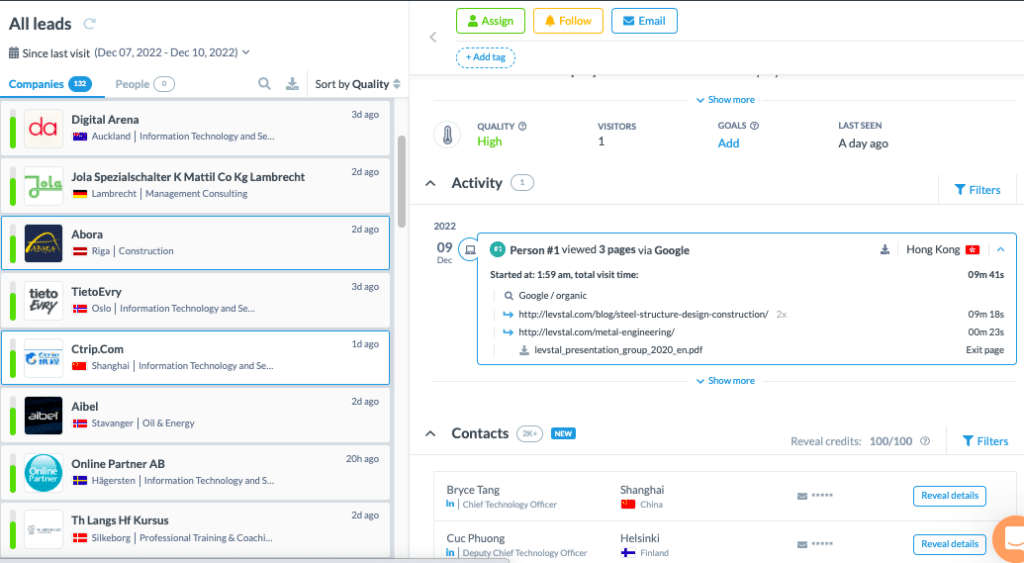
- The funding history can be looked up at CrunchBase. If you’re selling complicated solutions which affect business performance in one way or another, there is a possibility to look up all the investments, including not only the VC funds but the names of the partners who worked on a particular deal. You can get the opportunity for an outreach to the investor of your lead who can push your deal and help to close. CrunchBase and Owler also track the leadership changes which can be good buying signals, as well as acquisitions which sometimes provide opportunities to upsell to a newly added business division;
Now, I am going to present a brief overview of all of the tools I mentioned above:
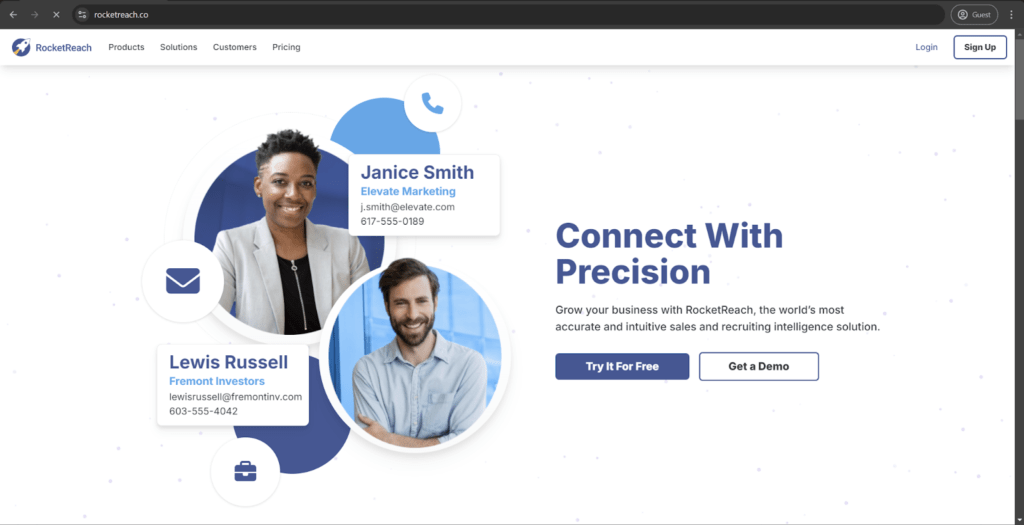
RocketReach is a helpful tool that makes it easier to find information on professionals across industries, including their social media accounts, phone numbers, email addresses, and so on. It is a marketing and sales tool, first and foremost, simplifying the process of reaching out to potential candidates or leads. It can be integrated with a lot of different marketing software, such as CRMs and email nurturing platforms, and there are also deep web scraping capabilities if you need to find information that is not discoverable by traditional means. RocketReach helps to assess the quality of the incoming leads leveraging its extensive database to enrich the lead data.
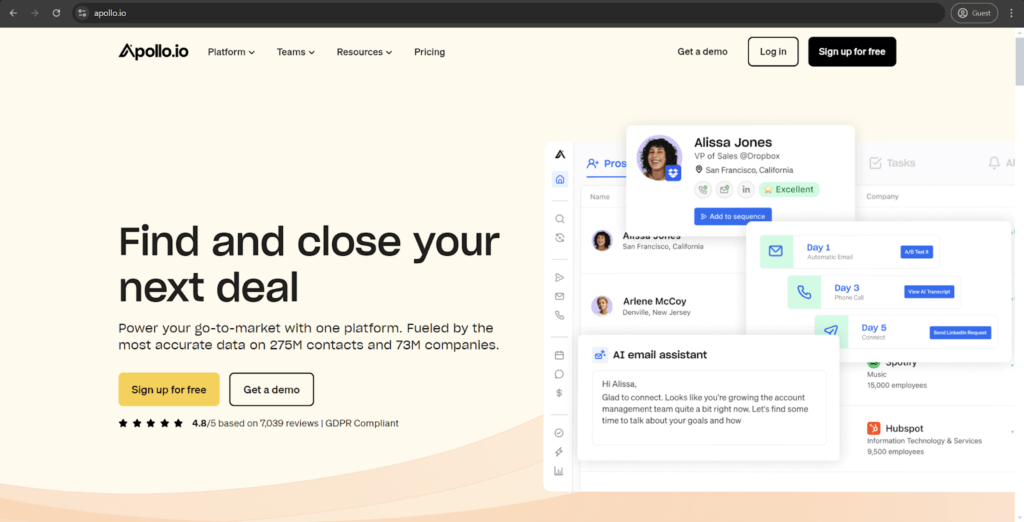
Apollo is a multifunctional platform that assists companies with finding and engaging with potential leads. It is a sales intelligence and engagement platform that combines multiple tools for CRM integration, automated sales, and email outreach with a flexible database of B2B contacts. The primary purpose of Apollo is to help marketing and sales teams streamline their outreach and prospecting processes, making it possible to scale lead-generation efforts with high efficiency.
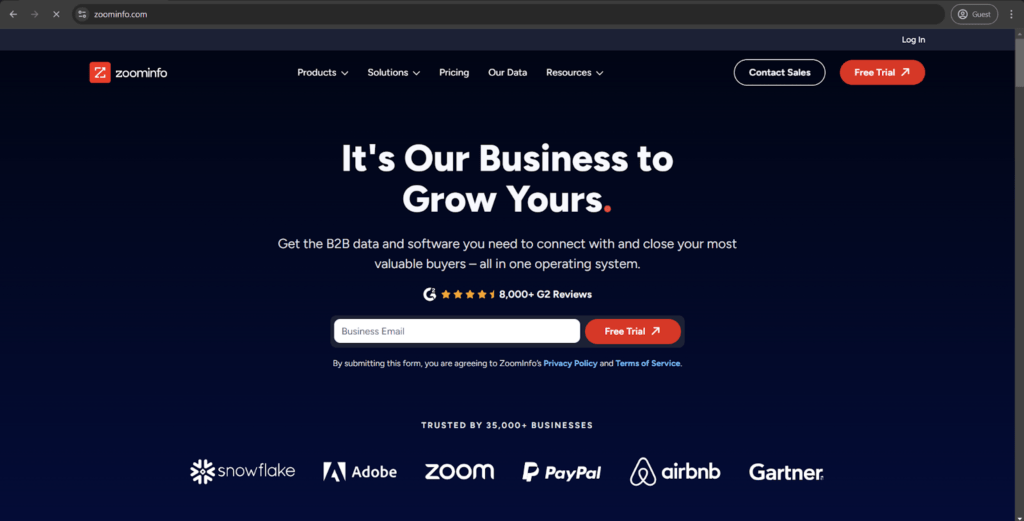
ZoomInfo is a lead generation platform and a B2B contact database in a single solution. It can offer detailed insights into various business-related information, including organizational structure, contact information, buying signals, and more. It is a popular tool for market research and lead generation, and its integration with HubSpot and Salesforce makes it even more valuable. It can also enhance the lead quality by leveraging its database, which is similar to RocketReach or Apollo.
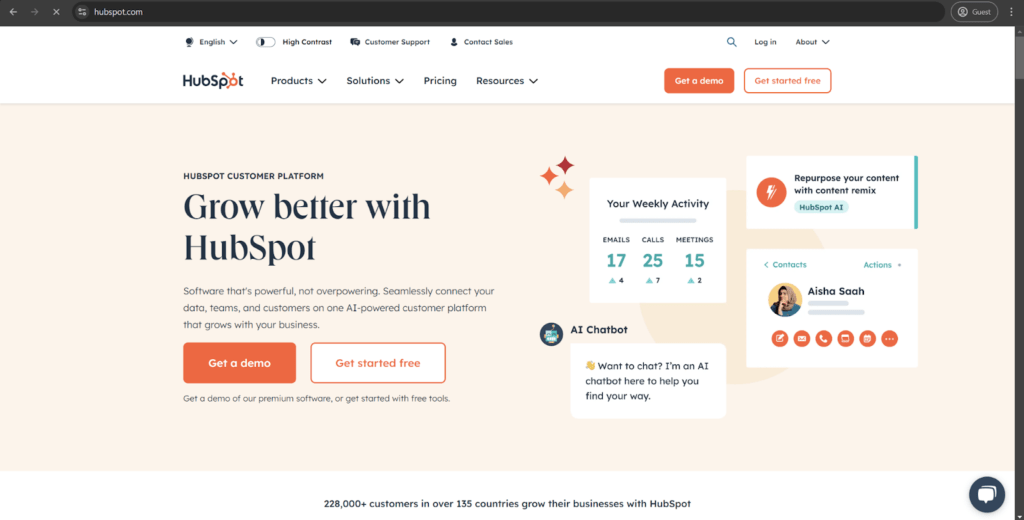
HubSpot is a complex CRM platform with inbound marketing and sales capabilities. The primary purpose of the solution is to attract, convert, and close customers at different stages of a buyer’s journey. HubSpot can offer lead nurturing, marketing automation, content management, extensive reporting, and many other features that make it invaluable in B2B marketing.
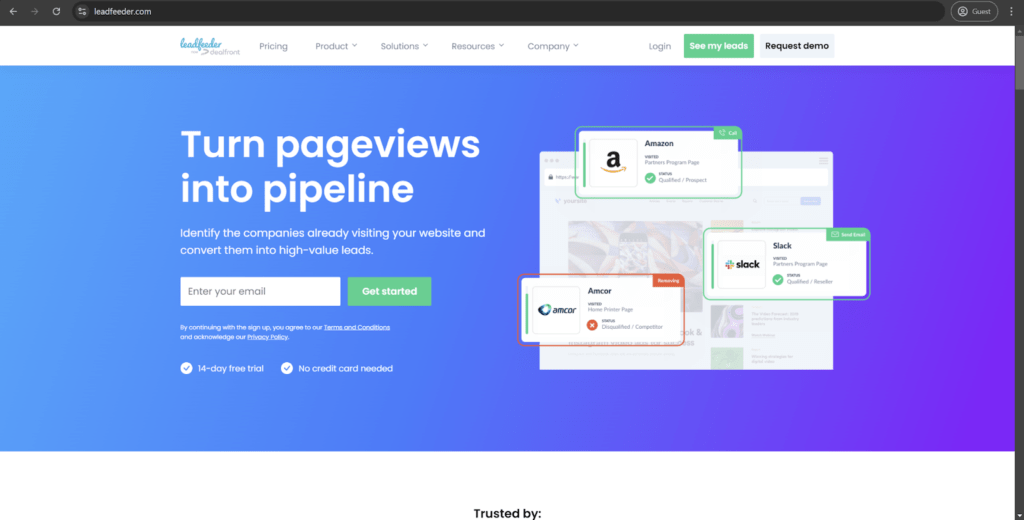
LeadFeeder is a website tracking solution that makes it easier to log and analyze what companies visit your website and how they behave during their visits. It can be integrated with Google Analytics, MailChimp and various CRMs in order to assist sales in following up warm leads based on website visit data and also send out campaigns to them. It is an essential tool when it comes to looking into anonymous website visitors since they can also be converted into actionable leads in some cases.
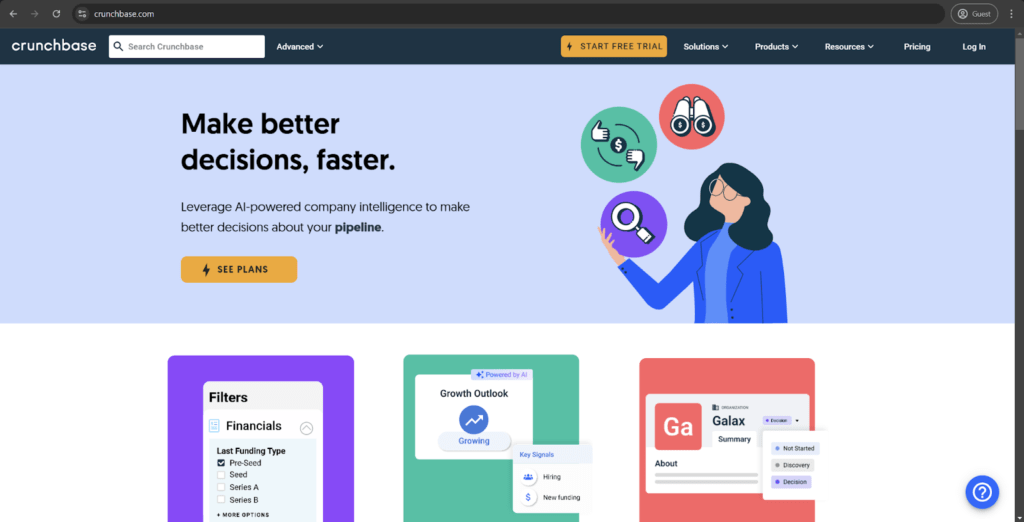
CrunchBase is a company information database that focuses on investors, startups, and funding rounds. It can provide not only general company information but also market activity, leadership, acquisitions, financials, and more. It is a common tool for investors and researchers, along with sales teams that wish to monitor industry trends and identify high-growth businesses.
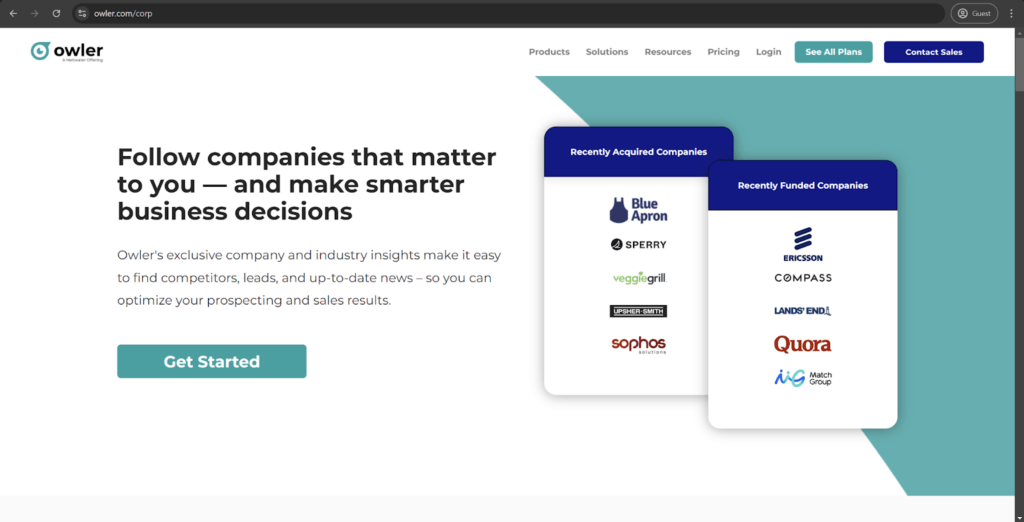
Owler is a platform for competitive analysis and business intelligence, it can offer multiple insights into a specific company – including their employee counts, revenue estimates, and competitor analysis. It is a great tool for tracking industry leads and their competitors, with alerts and real-time news presented in a convenient fashion. It can help marketers stay informed on different events in the industry while also providing an understanding on how successful specific competitors are.
The majority of data enrichment tools provide ways to automate the process using API or connectors that can plug directly into your CRM and supply all this information. However, manual research is also a good thing to do because it can provide even more insights that can only be found this way.
Leverage intent data
Digital marketing is evolving and it is no longer enough to just generate leads as it is, now you also have the opportunity to use buying intent data to improve lead conversion. Knowing the intent of the lead is crucial for how it can be approached by marketing or sales teams. By intent we usually mean 2 things: a) the products that the potential customer was looking for and b) the projects that the potential customer might be willing to launch (for example, the replacement of the backup system and storage or the improvement of the IT security system). Here are some of the most well-known intent data providers:
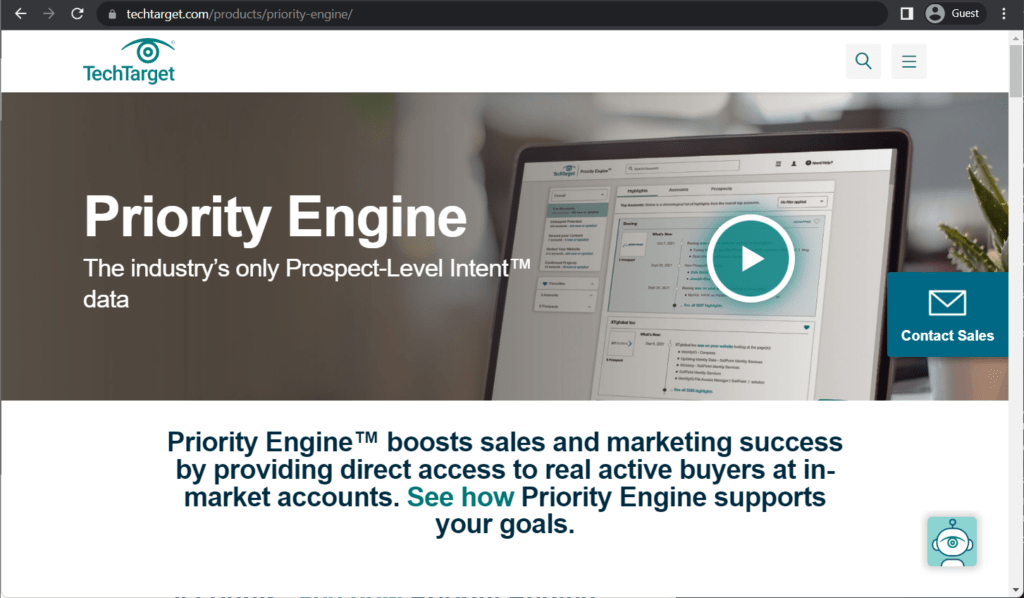
TechTarget is a company that specializes in “problem-solving content”, and their solutions cover thousands of specific topics in information technology. Priority Engine is TechTarget’s take on intent data solutions. Priority Engine provides behavior insights to both sales and marketing departments to ensure high-quality leads.

TrustRadius is a research and review platform for different software types that offers a multitude of ways to interact with all kinds of valuable information about software buyers and other data. TrustRadius can offer its vendors category-level intent data that helps a lot when it comes to targeting visitors of specific pages, including features such as LinkedIn Matched Audiences integration, Customer Voice package, and so on.

Demandbase is another unusual solution on this list, offering multiple features to its customers – with a specialization in Account Intelligence. This kind of information is gathered when customers are interacting with advertisements, sales departments, and other participants of the process. Their data is reliable and extremely useful, allowing its users to close deals faster, find new business opportunities easier, and have many other advantages.
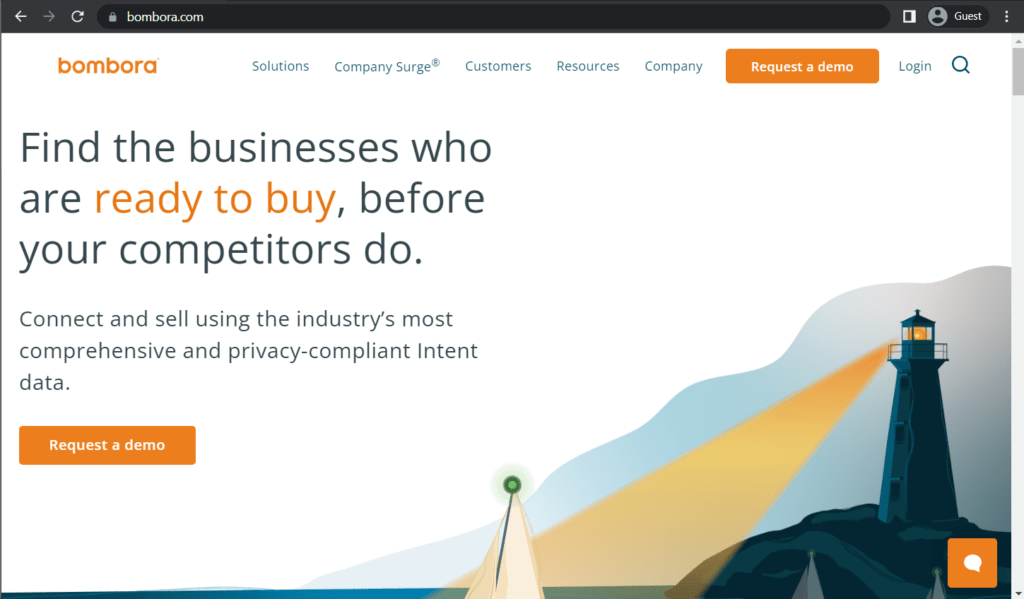
As with several other examples on this list, Bombora has its own patented data type called Company Surge, which claims to be extremely helpful when it comes to monitoring changes in product consumption with many filters and businesses. Bombora’s solution can help with aligning sales and marketing teams together, offering the capability to perform specific actions based on trustworthy data about their customers. The data itself is gathered using a large cooperative of B2B media companies from all over the planet, and each member of the cooperative shares behavioral data in exchange for better audience understanding, easier inventory monetization, and so on.
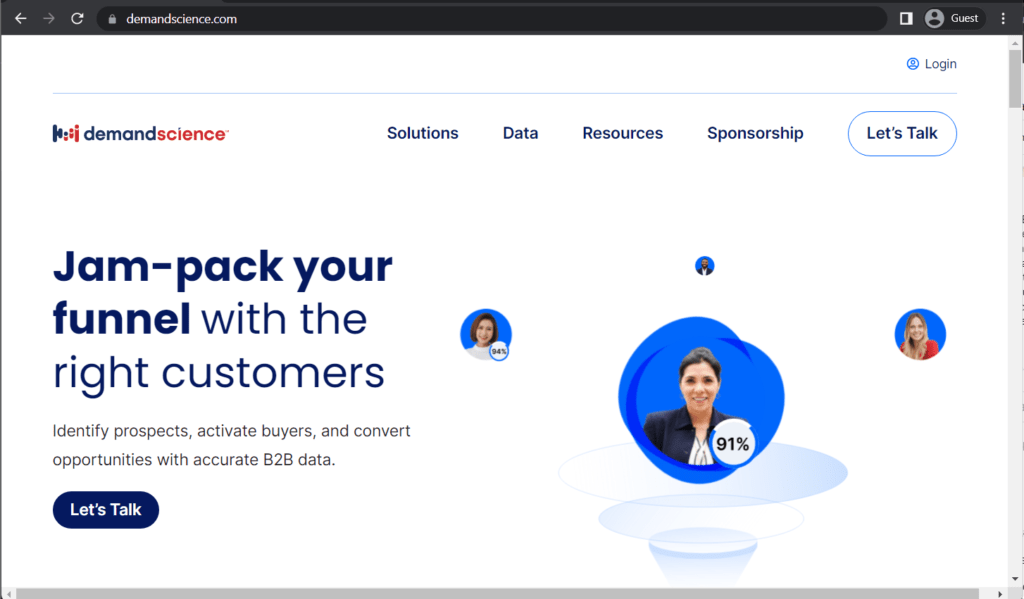
DemandScience is a software provider in the field of marketing solutions that offers a variety of features in the field, including account-based marketing, content syndication, data-driven marketing network based on intent, and more. DemandScience can help companies with boosting ROI, filling funnels and achieving growth goals by providing reliable predictive insights and accurate data on how customers behave and what their intentions are. This solution is a great way to drive quality leads and improve your customer targeting to make it as precise as possible.
Use bespoke landing pages for target audiences
If you notice that your PPC or social media paid campaigns are driving a diverse audience on a single landing page, there’s a high risk that you are losing high-quality leads. All you need to do is to make the landing pages relevant to the audience to get better quality leads. To do so, create landing pages that are customized according to specific clients’ buying personas, services, metrics or pain points using Unbounce or Instapage.
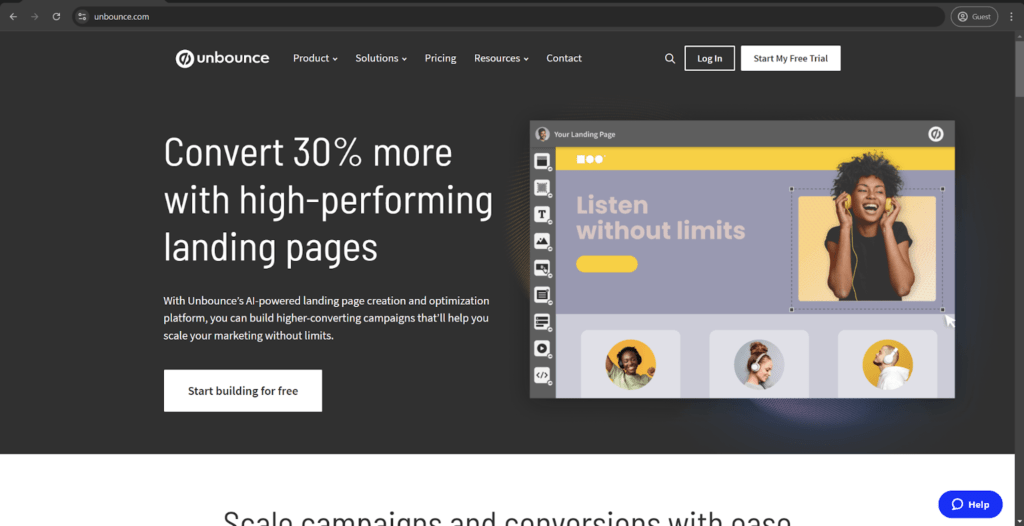
Unbounce is a landing page building service that can assist with creating customizable landing pages with high conversion levels – and there is no need to know any coding to do so. Dynamic text replacement, AI-powered optimization, and A/B testing are just a few examples of features that Unbounce can offer, making it possible to provide targeted high-performance landing pages for specific audience types. This kind of approach practically guarantees to increase both sales and lead generation efforts, if done correctly.
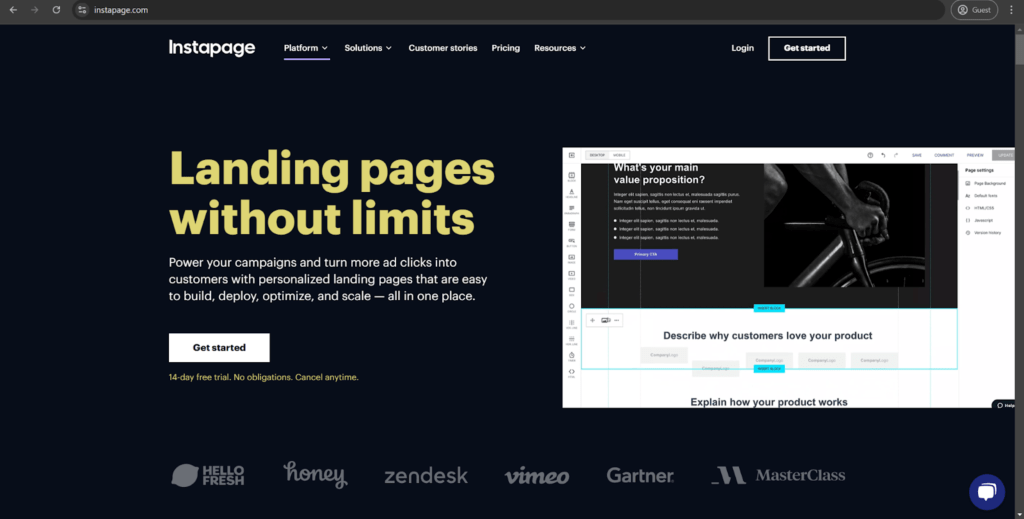
Instapage is another example of a landing page builder with an extensive feature set. It can offer heatmaps, A/B testing, and drag-and-drop page creation capabilities for a fast and versatile page creation process. The platform also simplifies targeting campaigns dramatically by integrating with multiple advertising and marketing platforms such as Google Ads.
Industry-specific or even account-specific landing pages can reinforce your value proposition. With such customization you will be able to increase lead quality as the generated leads will be highly relevant, which ultimately increases your conversion rate without incurring extra charges on your marketing budget.
Customize your website for target audiences
Website personalization tools, available in platforms like HubSpot and Optimonk, enable the customization of entire web resources beyond just landing pages. This technology allows for the targeted display of content such as case studies, whitepapers, and product recommendations, tailored to specific visitors.
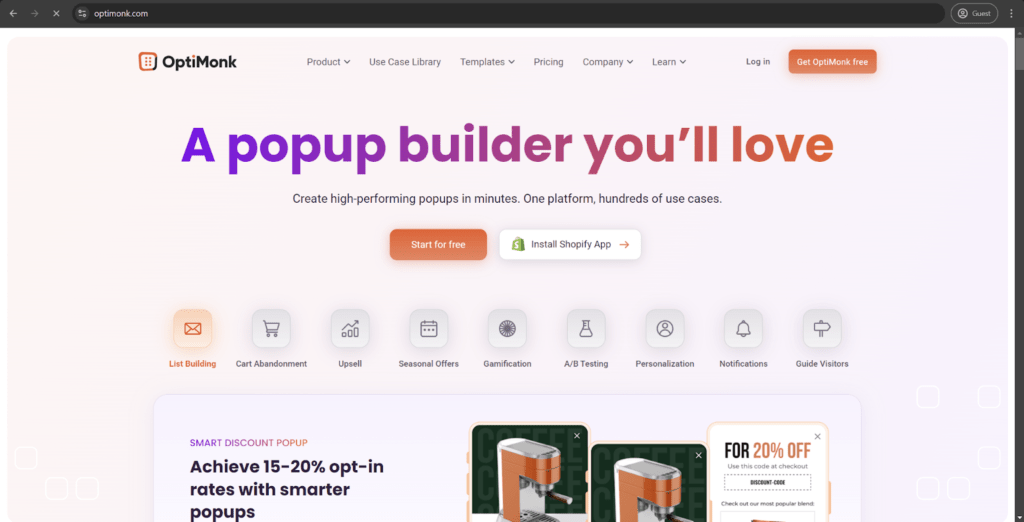
Optimonk is a noteworthy conversion rate optimization tool; its primary purpose is to assist businesses with lead capturing while using personalized advertisement elements such as website pop-ups to reduce cart abandonment rates. Optimonk helps users set up targeted marketing campaigns based on visitor behavior with the purpose of encouraging conversions, promoting discounts, and so on. It is widely used in the e-commerce business for customer retention and lead capturing.
By presenting relevant materials over multiple visits, businesses can nurture prospects towards conversion more effectively, simultaneously increasing lead quality. The lead quality is improved by increasing engagement, demonstrating relevance, educating prospects, identifying high-intent visitors, and accelerating the sales cycle.
Give your content a thorough review
Imagine you are a marketing manager at a SaaS company and your team is launching a project management tool for small businesses. Despite investing heavily in content marketing, you are only able to drive traffic with low conversion rates. Do you know what might be the reason? The potential cause can be the low-quality content. Make sure that your content resonates well with your target audience. It must contain their pain points and also offer your brand as a solution to them. In addition to this, use strong calls to action that evoke a sense of immediate engagement. Your marketing message must comprise the 4 Cs: clarity, conciseness, consistency, and compulsion. When your marketing message resonates with your target audience, the chances of better quality leads increase dramatically.
Use focus keywords to get discovered
According to a certain statistic, 4 out of 5 Google searches have local intent. The potential of localized keywords is massive, especially when used in the right context, such as for a business that targets specific regions. The localized search is any case of a search query that includes phrases such as “local” or a specific location keyword – city, street, etc.
A procurement manager in a B2B company is going to use search queries such as “industrial equipment supplier [city_name]” or “local manufacturing equipment vendor.” Both of these options are considered localized searches. A lot of businesses miss out on optimizing their content with these kinds of strategies in mind since there is always the need for local, targeted solutions to specific issues.
Localized keywords also have the power to dramatically improve the lead quality. Accounts with specific location-based needs are going to be far more likely to have a high purchasing intent from the get-go as they are already looking for a solution to their issue. Other advantages of localized search include filtering out irrelevant content, thus improving the lead-to-opportunity conversion rates.
Utilize influencer marketing to your advantage
In 2022, the market size of influencer marketing was estimated at $15 billion. This staggering figure indicates that if you are not using influencer marketing to excel in the number of leads, you are still missing out on multiple opportunities. When you partner with the ones whose followers match your target audience, people consider your product or business authentic which will ultimately convert them into quality leads. The key tip is to focus on micro-influencers instead of macro-influencers as they have small but more engaged followers.
Micro-influencers are authentic and trustworthy in their niches. This helps them connect well with potential leads. They can reach specific groups, leading to better conversions. Working with micro-influencers is often cheaper. This lets businesses partner with more influencers. Micro-influencers have high engagement rates. Their followers ask questions and join discussions. This creates good opportunities for lead nurturing. It can increase both the number and quality of leads.
Focus on high-engagement channels
If you want to improve the quality of your leads, instead of jumping into all grounds, focus on the high-value channels. However, there are no standardized high-value channels but the platforms vary from brand to brand depending upon the target audience and industry. This is why high-value channels can be any from social media platforms, search engines, industry forums, or professional networks. To identify which one is best for you, understand your target audience and look from which channel you are getting the highest number of high-quality leads.
Conclusion
High-quality lead generation for me is a topic which arises at a certain moment with literally all of my customers, even with those who hire me for totally different services and goals. This shows the real landscape of this problem nowadays, there are a lot of ways to generate leads, but simultaneously there are a lot of cases when marketing campaigns drive low-quality leads and something needs to be changed.
It’s extremely important to define what is a quality lead for your business, what are your MQL and SQL criteria. Defining the factors of lead quality measurement will allow the discussions between you as a client or stakeholder, your agency or internal marketing team and your management or sales team be informative, meaningful and constructive.
In this article, I have tried going over not only the definition of lead quality and several subsequent parameters but also multiple tips for improving lead quality, a number of recommendations on how to improve the lead identification process, and the general advantages of higher lead quality. Additionally, I went over the future of lead qualification and the impact of privacy regulations on this branch of marketing.
I highly encourage you to try the aforementioned tips and recommendations in your organization. With the right execution, you will see an almost immediate effect on the quality of your leads and the lead qualification process. These methods are cost-effective and don’t require a lot of investment along with C-level management approvals.
As the marketing industry is continuously evolving, if you are aiming to capture leads with traditional methods, you are missing out on a huge number of leads. Do comprehensive digital competitor analysis and come up with unique, innovative marketing strategies to attract high-quality leads.
Frequently Asked Questions
How do the lead enrichment tools enhance the lead quality?
Lead enrichment solutions can add valuable information to existing lead profiles – be it behavioral data, firmographic details, etc. The wealth of information dramatically improves the lead qualification process, making it easier to focus on the highest-quality leads available and not waste resources for no reason. The aforementioned ZoomInfo is widely considered one of the best tools for lead enrichment.
How can I prevent low-quality leads from appearing in the sales pipeline?
Lead qualification criteria, along with lead scoring, are the best way of approaching this topic. Form fields on landing pages that ask for relevant information can be used to gather data, and disqualification rules can help filter out leads that you are not interested in from the get-go. The overall accuracy of qualification can also be enhanced by using progressive profiling.
Is it possible to prioritize high-quality leads if the resources are limited?
It should still be possible to act upon the lead qualification process results, even with limited resources. Focusing on the highest quality leads is a recommended strategy in these cases, too, since these leads often have the highest conversion likelihood. Additionally, there are plenty of CRM tools that can be used to add features such as automated nurturing or customizable alerts to increase the efficiency of lead generation.
How can social media platforms affect lead quality in a B2B environment?
LinkedIn is one of the most commonly used social media platforms in this environment, and its rich toolset makes it possible to target leads based on numerous parameters – companies, job titles, industries, etc. It is also possible to use social listening tools to provide even more targeted outreach by finding prospects that experience challenges your product can solve. Another important factor for lead attraction as a whole is the existence of social proof – testimonials and case studies shared on social media platforms.
What are the most common mistakes when it comes to improving the lead quality?
Prioritizing quantity instead of quality is the first large red flag in this topic. Additionally, the inability to aligh marketing and sales departments leads to significant efficiency loss, and the lack of a proper lead nurturing process drastically reduces the likelihood of conversion. The usage of generic metrics in a market full of personalization and individualization is completely unacceptable, and the inability to locate the necessary metrics for tracking would not make it possible for the marketer to have a clear understanding of which practices work and which do not.


